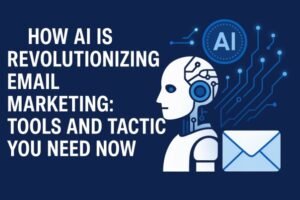In 2025, the digital marketing landscape looks nothing like it did just a few years ago. At the center of this transformation? Chatbots in digital marketing are powered by AI and built with no-code tools. From automating conversations to personalizing customer journeys, these smart assistants are doing more than just chatting; they’re driving conversions.
Let’s dive deep into how AI-powered chatbots and assistants are reshaping marketing strategies and how even small businesses can harness them without writing a single line of code.
Why 2025 Is the Year of Chatbots in Digital Marketing
The Growing Demand for 24/7 Engagement
Today’s customers expect instant replies — no waiting, no delays. AI chatbots ensure that businesses are always on, handling inquiries, collecting leads, and even closing sales while you sleep.
No-Code Tools Lower the Barrier
Once a developer’s domain, chatbot creation is now possible with drag-and-drop tools like Tidio, Chatfuel, ManyChat, and Landbot. These no-code platforms let marketers launch smart bots in hours, not weeks.
Did You Know? Businesses that use chatbots on websites have seen a 67% increase in lead conversions, according to Drift’s 2025 report.
Real-Life Example: Small Business, Big Impact
Farzana’s Boutique, a small fashion store in Bangladesh, used a no-code chatbot (Tidio) to handle Facebook and website queries. The result?
- 80% reduction in abandoned carts
- 50% increase in return customers
- Zero need for a full-time customer service rep
How Chatbots Work in Digital Marketing
1. AI Chatbots for Marketing Automation
- Chatbots powered by AI can:
- Qualify leads automatically
- Send reminders about abandoned carts
- Recommend products using past behavior
- Answer FAQs with NLP (Natural Language Processing)
2. Chatbots for Website Marketing
A well-placed chatbot can pop up on key pages (like pricing or checkout), offering help, discounts, or guidance — boosting conversions right where customers need support.
3. Social Media & Messenger Bots
With Messenger, WhatsApp, and Instagram integrations, bots now reply instantly to DMs, run giveaways, or guide customers through purchases, directly inside the platform.
Top No-Code Chatbot Platforms (2025 Comparison Table)
| Platform | Best For | Features | Price (Starter) |
|---|---|---|---|
| Tidio | Shopify & WooCommerce users | Live chat + AI chatbot | $29/mo |
| Landbot | Website lead gen | Drag-drop builder, integrations | $30/mo |
| ManyChat | Instagram & Facebook | Messenger automation, flows | $15/mo |
| Chatfuel | E-commerce, FAQs | AI-powered templates | $15/mo |
| Botpress | Enterprise AI bots | Multilingual, advanced NLP | Free/$50+ |
The Role of AI Marketing Automation
AI assistants go beyond chat. They:
- Segment audiences automatically
- Personalize email campaigns
- Analyze user behavior and adapt responses
- Predict customer needs using past data
These tools integrate directly with platforms like HubSpot, Mailchimp, or Google Ads, letting marketers set and forget much of the customer journey.
Global Trends: AI Marketing Tools Adoption
| Region | % of Businesses Using AI Chatbots |
|---|---|
| North America | 72% |
| Europe | 67% |
| Asia-Pacific | 81% |
| Africa | 45% |
| South America | 53% |
Stat Source: HubSpot AI Trends Report, Q1 2025
Benefits of Chatbots in Digital Marketing
1. Hyper-Personalized Experiences
Chatbots learn from interactions. They greet returning users by name, remember preferences, and tailor offers.
2. Increased Conversions
Bots reduce drop-offs. A well-designed chatbot can act as a virtual salesperson, answering objections in real time.
3. Time-Saving for Teams
Automation allows small teams to focus on strategy, not customer service tickets.
4. Scalable Customer Engagement
Whether you have 100 or 100,000 visitors, your chatbot can handle it — no salary, no burnout.
Challenges and How to Overcome Them
| Challenge | Solution |
|---|---|
| Poor responses | Train with FAQs + real data |
| Users drop the conversation | Use human takeover features |
| Limited personalization | Integrate CRM or Google Sheets to enhance context |
| Language/region barriers | Use multilingual bot frameworks (e.g., Botpress) |
Expert Insight
“In 2025, chatbots aren’t just a nice-to-have. They’re mission-critical. Brands without them will fall behind.”
— Arnav Sharma, AI Strategist at Hootsuite
“Thanks to no-code platforms, anyone — from solopreneurs to NGOs — can launch their own intelligent assistants and delight customers.”
— Jessica Lin, Co-Founder at Landbot.io
How to Build a Chatbot with No-Code (Step-by-Step)
- Pick a Goal: Lead generation? Support? Product recommendation?
- Choose a Platform: Try free plans from Tidio or ManyChat
- Design Flows: Use simple logic like “If user says X, then reply Y”
- Connect to Tools: Plug in email, Google Sheets, CRM, etc.
- Test & Improve: Use analytics to tweak and grow.
Pro Tip: Use A/B testing on different chatbot scripts to improve response and conversion rates.
Future of Chatbots in Digital Marketing
- Voice-enabled bots will integrate with Alexa and Google Assistant
- Visual chatbots will guide users with product carousels, video demos
- Sentiment analysis will adapt tone based on customer mood
- Bots as influencers: AI bots with personalities engaging fans on TikTok
Don’t Get Left Behind
In the fast-paced world of 2025, chatbots and AI assistants are no longer optional. They’re essential. Whether you’re a solo entrepreneur or a growing brand, using chatbots in digital marketing can multiply your reach, streamline customer support, and boost conversions all without touching code.
No longer a futuristic concept, AI chatbots are your digital co-workers. And the best part? You can start using them today, even on a small budget.
Action Steps
- Try building your first bot on a no-code platform today
- Add it to your website or social page
- Watch your customer engagement and conversions climb
What’s holding you back from adding an AI assistant to your strategy? Drop your thoughts in the comments or share this article with your network!
If you found this guide helpful, don’t forget to bookmark this post and subscribe for more insights on AI, automation, and digital growth strategies.




